
Three garden surprises
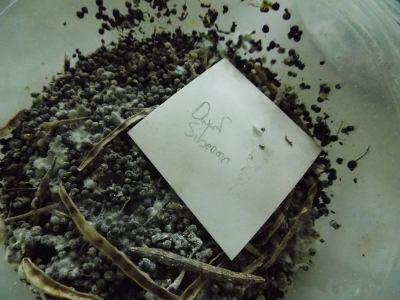 I had three surprises
Thursday --- one unpleasant, one pleasant, and one
interesting. Mark always takes his surprises from worst to
best, so I'll write this post that way too.
I had three surprises
Thursday --- one unpleasant, one pleasant, and one
interesting. Mark always takes his surprises from worst to
best, so I'll write this post that way too.
The unpleasant
surprise came when I pulled out the kale seeds I'd saved this
spring in preparation for planting our fall crop. The seeds
had rotted in the container! I'm usually pretty good about
harvesting seeds when they're as dry as possible, then letting
them sit out for another week or two in an open container to
finish dehydrating (especially if I'm going to seal them in
plastic instead of paper), but I clearly missed a step somewhere
along the way. Luckily, I have some 2012 seeds still kicking
around for one kale variety, and have time to order more of the
second variety since the whole month of August works for kale
planting around here. (I also snuck in a packet of Laciniato
kale into my seed order to try yet another variety.)
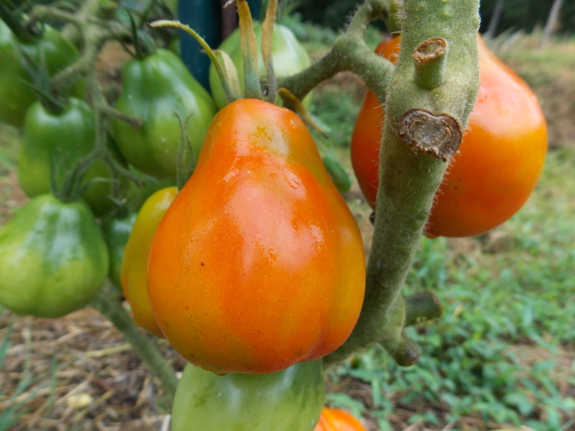
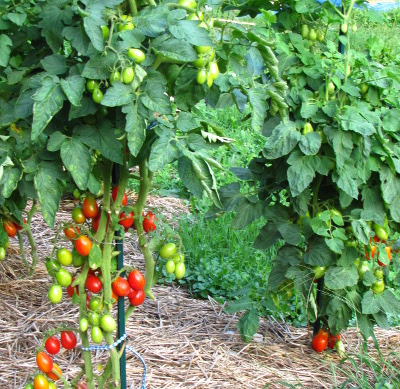 The interesting surprise came in the tomato
patch, where one of my yellow romas turned into an orangish roma
instead. Last year, a totally new tomato variety popped up
in my garden (shown to the right), and I assumed the seed had come
in with the manure. But now that I've seen this happen two
years in a row, I think I'm seeing the unusual-but-possible
effects of tomato hybridization. (Tomatoes are usually
self-pollinating, so you can grow several varieties in the same
patch even when saving seeds, but nature doesn't always play by
the rules.) I'm guessing this year's hybrid is probably a
Yellow Roma mixed with a Japanese
Black Trifele,
and I like the way I get the indeterminate, vigorous nature of the
Yellow Roma along with a heavier fruit set and a reddish
fruit. Last year's little red roma bred true, so I'll save
some seeds of the new hybrid too and will start pondering names
for my newly created tomato varieties.
The interesting surprise came in the tomato
patch, where one of my yellow romas turned into an orangish roma
instead. Last year, a totally new tomato variety popped up
in my garden (shown to the right), and I assumed the seed had come
in with the manure. But now that I've seen this happen two
years in a row, I think I'm seeing the unusual-but-possible
effects of tomato hybridization. (Tomatoes are usually
self-pollinating, so you can grow several varieties in the same
patch even when saving seeds, but nature doesn't always play by
the rules.) I'm guessing this year's hybrid is probably a
Yellow Roma mixed with a Japanese
Black Trifele,
and I like the way I get the indeterminate, vigorous nature of the
Yellow Roma along with a heavier fruit set and a reddish
fruit. Last year's little red roma bred true, so I'll save
some seeds of the new hybrid too and will start pondering names
for my newly created tomato varieties.
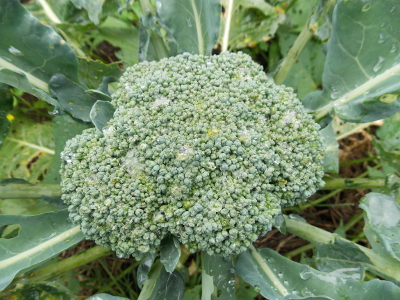 The final surprise was a
spring broccoli plant that produced a delicious head in
August! Usually, I rip out any spring broccoli that doesn't
mature in a timely manner since summer's heat prompts the plants
to produce measly heads that aren't worth the garden space.
But this broccoli was tucked away in the forest garden, so I
forgot about it. And the cool wet summer resulted in
beautiful head after all! I guess I should have been more
serious about planting broccoli during this wet summer to take the
place of our ailing tomatoes. I did have an extra dozen
brussels sprouts sets, though, which are now getting their feet
under them between the soon-to-be-gone tomatoes:
The final surprise was a
spring broccoli plant that produced a delicious head in
August! Usually, I rip out any spring broccoli that doesn't
mature in a timely manner since summer's heat prompts the plants
to produce measly heads that aren't worth the garden space.
But this broccoli was tucked away in the forest garden, so I
forgot about it. And the cool wet summer resulted in
beautiful head after all! I guess I should have been more
serious about planting broccoli during this wet summer to take the
place of our ailing tomatoes. I did have an extra dozen
brussels sprouts sets, though, which are now getting their feet
under them between the soon-to-be-gone tomatoes:
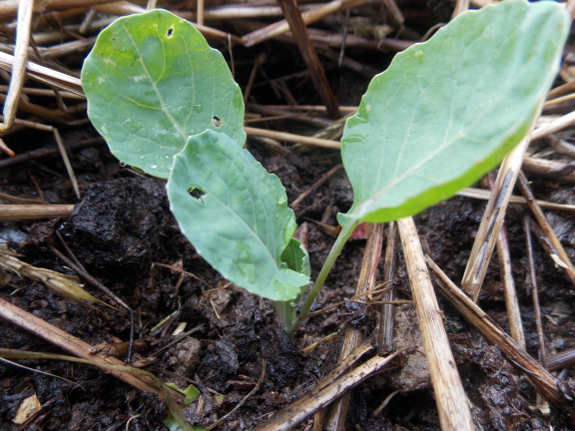
Any surprises lately
in your garden?
Want more in-depth information? Browse through our books.
Or explore more posts by date or by subject.
About us: Anna Hess and Mark Hamilton spent over a decade living self-sufficiently in the mountains of Virginia before moving north to start over from scratch in the foothills of Ohio. They've experimented with permaculture, no-till gardening, trailersteading, home-based microbusinesses and much more, writing about their adventures in both blogs and books.
Want to be notified when new comments are posted on this page? Click on the RSS button after you add a comment to subscribe to the comment feed, or simply check the box beside "email replies to me" while writing your comment.

Can you explain that? I thought, with a hybrid, that you might not get the hybrid, but more, one of the parents with saved seed?
A surprise in my garden is that my mulching with that good earth you got for me seems to have strengthened my tomatoes so that their leaves don't seem to be blighting, the way they had been, in all the rain (I carefrully took off those leaves, on each plant, earlier, actually the way Onie used to care for her African violets).
Another discovery has been that a few Blue Lake bean seeds that had gotten dropped near the sage, have turned into lush plants, draped over 1/2 of that sage, and then all over the asparagus...so that I have a real tangle, but somehow they are not killing either support plant, and I guess are different from when morning-glory takes over. Probably all the rain has been enough for all three kinds of plants. Have to side-dress that sturdy sage, tho!
btw--I really like that book you lent me, Making Home, by Sharon Astryk--it's inspiring me to once more "red up" my gardening supplies in the basement, and to visit neighbor's gardens!
We grow enough mustard to have all the greens we want, but not enough to have seeds to make a decent batch of mustard sauce. After three years, I'd finally saved up enough to make some. I'd been keeping them all in a spice jar in the spice drawer. I took out the jar only to find I hadn't dried this years seeds fully. The whole batch - all three years' worth - had molded.
In surprising news - our rainbow chard is still producing quite happily. This is August in Portland, OR. Not your summers in Virginia, true, but still quite surprising. In fact, I spotted a couple of ripe strawberries in the berry patch. WTF?
In the meantime, I'm working on getting my yard certified by the Backyard Habitat Certification Program through the local Audubon chapter, and sorting through how much of their approved "native plant" list is edible. More than I'd initially thought! Plus some of the list will also bring in pollinators for the food plants, so it's going to be a big win all around.
Mom --- Hybrids are like your kids --- every one different, and showing some traits of each parent. I'm not actually 100% clear on why a hybrid would breed true the next year, though, as our little red romas seem to have. Even self-pollinating, there should be enough genetic variability that they'd have differing offspring. Crop genetics is pretty complicated, and I clearly don't know it as well as I should!
(Fun to hear everyone's surprises!)